
The Australian Defence Force (ADF) is the military organisation responsible for the defence of the Commonwealth of Australia and its national interests. It has three branches: the Royal Australian Navy (RAN), Australian Army and the Royal Australian Air Force (RAAF). The ADF has a strength of just over 90,000 personnel and is supported by the Department of Defence and several other civilian agencies.

The Australian contribution to the war in Afghanistan has been known as Operation Slipper (2001–2014) and Operation Highroad (2015-2021).
The Kosovo Campaign Medal (KCM) is a military award of the United States Armed Forces established by Executive Order 13154 of President Bill Clinton on May 3, 2000. The medal recognizes military service performed in Kosovo from March 24, 1999 through December 31, 2013.
The NATO Medal is an international military decoration which is awarded to various militaries of the world under the authority of the North Atlantic Treaty Organization (NATO). It is manufactured by Eekelers-Centini Intl, of Hemiksem, Belgium.

The Australian Active Service Medal (AASM) is an Australian military decoration. It was authorised on 13 September 1988 to recognise prescribed service in "warlike" operations, backdated to February 1975. It is awarded with a clasp to denote the prescribed operation and subsequent awards of the medal are made in the form of additional clasps. In 2012, it was announced that the medal would no longer be issued for future operations, with the AASM and the Australian Service Medal being replaced by the Australian Operational Service Medal.

The Gulf War Medal was a campaign medal approved in 1992, for issue to officers and men of British forces who served in Kuwait and Saudi Arabia during Operation Granby in 1990–91.

The Operational Service Medal for Afghanistan is a campaign medal previously awarded by the Ministry of Defence of the United Kingdom for service by British Armed Forces personnel in support of the post-2001 Afghan War.
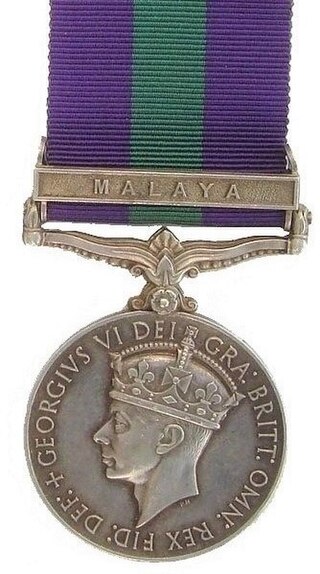
The General Service Medal was instituted to recognise service in minor Army and Royal Air Force operations for which no separate medal was intended. Local forces, including police, qualified for many of the clasps, as could units of the Indian Army prior to 1947.

The General Service Medal, is a campaign medal of the United Kingdom introduced in 1962 to replace both the General Service Medal (1918), as awarded to the Army and RAF, and the Naval General Service Medal (1915). The 1962 GSM was awarded until 2007, when it was replaced by the Operational Service Medal. In 2015 the General Service Medal (2008) was introduced.

The Humanitarian Overseas Service Medal is an award in the Australian honours system. The award is presented to those who perform humanitarian service in a foreign country, in particular those working in dangerous environments or conditions or during a humanitarian crisis. The award was introduced by letters patent on 16 April 1999, following a review of the Australian honours and awards system beginning in 1995.

The Iraq Medal was instituted by Queen Elizabeth II, Queen of Australia on the advice of the Australian Prime Minister John Howard in 2004. The Iraq Medal is awarded to Australian Defence Force (ADF) personnel who served in or around Iraq. ADF personnel are also recognised by the 'IRAQ 2003' clasp to the Australian Active Service Medal.
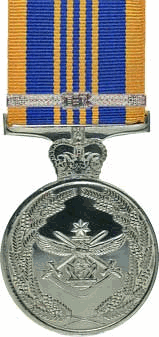
The Defence Long Service Medal is an Australian military award given for long service by permanent and reserve members of the Australian Defence Force (ADF), irrespective of rank. It was introduced in 1998, and replaced the suite of ADF service awards introduced in 1982, which comprised the Defence Force Service Medal, the Reserve Force Medal and the Reserve Force Decoration.
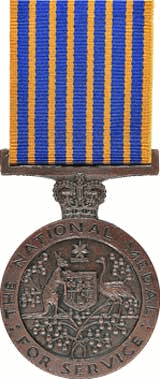
The National Medal is an Australian award given for long service by operational members of specified eligible organisations. It was introduced in 1975, as an original component of the new Australian honours system, and replaced a range of medals available to military and civilian uniformed services for long service and good conduct. The eligible groups have in common that their members serve or protect the community at the risk of death, injury or trauma, hence it is only available to members of the eligible organisations who are operationally deployed. In the case of corrective services, eligibility is restricted to officers with custodial duties.

The Australian Active Service Medal 1945–1975 recognises the service of Australian Defence Force and certain other persons in prescribed warlike operations in the period after World War II, and prior to February 1975. The medal was established in December 1997. The Australian Active Service Medal recognises warlike service after February 1975 until 2012 when the Australian Operational Service Medal was instituted.

The Australian Service Medal 1945–1975 recognises service in peacekeeping or non-warlike operations in the 30-year period following World War II, and prior to February 1975. The medal was established on 22 February 1995. The Australian Service Medal recognises non-warlike service after February 1975.
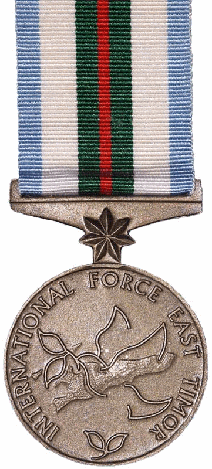
The International Force East Timor (INTERFET) Medal recognises members of the Australian Defence Force who served for 30 days in East Timor during the INTERFET campaign. The qualifying area comprises East Timor and the sea adjacent to East Timor out to a distance of 12 nautical miles (22 km) from the low water mark.

The Australian Service Medal is an Australian military decoration. It was authorised 13 September 1988 to recognise prescribed service in peacekeeping and non-warlike operations. It is awarded with a clasp to denote the prescribed operation and subsequent awards of the medal are made in the form of additional clasps. The Australian Service Medal 1945–1975 recognises non-warlike service prior to February 1975. The Australian Service Medal was replaced in 2012 by the Australian Operational Service Medal, except for ongoing missions.
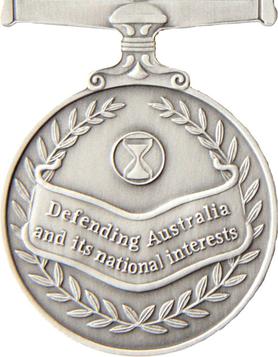
The Australian Operational Service Medal is a campaign medal established on 22 May 2012 to recognise service by Australian Defence Force (ADF) personnel on designated hazardous operations. It may also be awarded to civilians who serve alongside the ADF on designated operations under specific conditions.
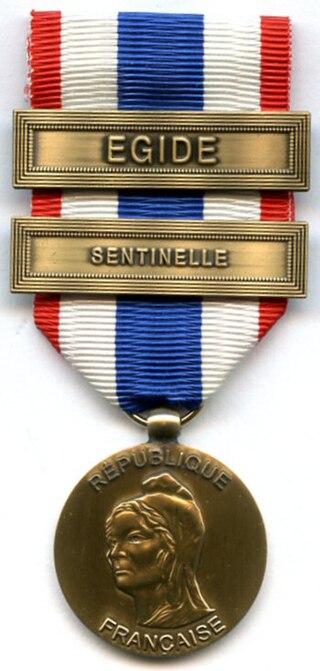
The Medal for the Military Protection of the Territory is a French state decoration established on 13 July 2015 by presidential decree 2015-853 and awarded to military personnel of the French Armed Forces for service during national security operations on French national territory. It was created to recognize service following the need for an increased military presence during national security operations following the rise of international terrorism and the many incidents in France over the past years.

The Operational Service Medal Iraq and Syria or Operation Shader Medal is a British armed forces campaign medal, awarded mostly to military personnel who served in the operational area of, or in support of Operation Shader. The medal was first announced by former Defence Secretary, Sir Michael Fallon on 19 September 2017. It was first awarded, to service personnel, on 18 July 2018 in London by Defence Secretary Gavin Williamson. This Operational Service Medal is the first medal of the contemporary era to be awarded to individuals who served outside of the operational area, reflecting the changing nature of warfare.



















